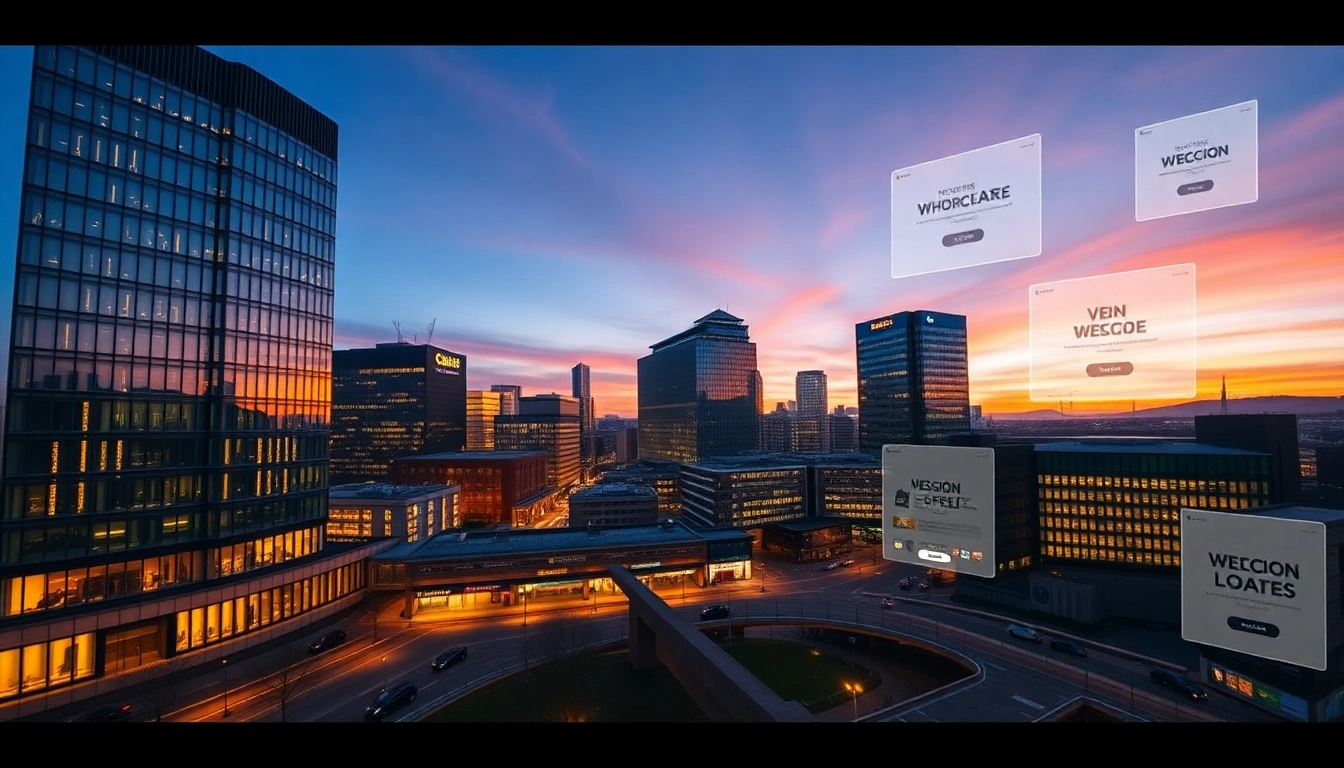Understanding Website Design Manchester
Website design is a crucial factor in establishing your brand’s online presence, particularly in a vibrant city like Manchester. Known for its rich industrial heritage and creative communities, the demand for website design Manchester continues to grow as businesses vie for attention in the competitive digital landscape. Understanding the nuances of local preferences and trends is essential for creating an effective web presence that not only captivates visitors but is architecturally sound and user-friendly.
What Makes Website Design in Manchester Unique?
When it comes to website design in Manchester, several factors make the city’s approach distinct. The fusion of cultural richness with technological advancement means that designers here often prioritize innovation while respecting traditional elements. As a result, the aesthetics of Manchester’s websites reflect the city’s dynamic atmosphere, often incorporating local color palettes, imagery, and themes that resonate with the community.
Moreover, many agencies leverage Manchester’s technological ecosystem, harnessing tools and methods that are unique to the region. This strategic synergy not only enhances the creativity involved in web design but also encourages a multi-disciplinary approach to campaign development, often involving collaboration between graphic designers, UX/UI specialists, and SEO strategists.
Key Features of Effective Website Design
The effectiveness of a website can often be traced back to several key features that must be present. Firstly, a clear and responsive layout is non-negotiable. Websites must adapt seamlessly to various devices, ensuring a consistent experience across desktops, tablets, and smartphones.
- Intuitive Navigation: Users should find it effortless to browse and locate information. Effective navigation is typically achieved through well-structured menus and clear calls-to-action.
- Visual Hierarchy: Important elements should stand out, using size, color, and placement to guide the visitor’s attention toward crucial information.
- Fast Load Times: A slow website can lead to high bounce rates. Effective website design takes speed into consideration by optimizing images and employing efficient coding practices.
- Compelling Call-to-Actions (CTAs): Engaging CTAs encourage users to take desired actions, whether signing up for a newsletter, making a purchase, or contacting the business.
Creating a visually appealing design that communicates the brand’s identity while ensuring these features are present significantly elevates user experience and encompasses effective website design.
Local Trends in Website Development
Web development in Manchester is constantly evolving, reflecting both technological advancements and shifting consumer preferences. Key trends observed currently include:
- Minimalist Designs: Clean and simple aesthetics are gaining traction, prompting designers to focus more on content rather than excessive embellishments.
- Dark Mode Options: Many users prefer dark themes for user-friendly experiences that reduce eye strain. This trend is increasingly being integrated into design strategies.
- Asymmetrical Layouts: Moving away from the traditional grid format, asymmetrical layouts offer a more dynamic feel and engage users in new ways.
- Micro-animations: Subtle animations can create a more interactive experience, captivating users and encouraging longer site visits.
These trends highlight how Manchester’s website design agencies are innovating while also understanding local culture and preferences, making the digital space more visually appealing and user-centric.
The Importance of User Experience in Design
In today’s digital marketplace, user experience (UX) is paramount. A well-designed website not only attracts visitors but also engages them, increases conversion rates, and fosters customer loyalty. As businesses in Manchester seek to distinguish themselves, understanding the correlation between user experience and effective design is essential.
Why User Experience Matters for Your Website
User experience is the silent ambassador of your brand online. Poor user experience can lead to frustration and lost opportunities. According to research, poor usability can lead to a 70% decrease in potential conversions. Therefore, prioritizing UX can significantly impact a website’s performance and overall business objectives.
Best Practices for Enhancing User Experience
To enhance user experience, consider implementing these best practices:
- Conduct User Research: Understanding your target audience’s preferences, behaviors, and pain points can guide effective design decisions.
- Fast Responses: Ensuring rapid page loading, as users tend to abandon sites that lag.
- Accessibility Features: Designing with accessibility in mind ensures that everyone, including those with disabilities, can use your site effectively.
- Regular Testing: Conduct usability testing often to identify areas for improvement and iterate based on user feedback.
Case Studies: Successful UX Implementations
Consider the case of a Manchester-based eCommerce company that, after comprehensive user research, revamped its website to streamline navigation and optimize the mobile experience. They reported a 50% increase in mobile conversions and a decrease in Cart Abandonment rates post-redesign. Such improvements reflect the positive outcomes of prioritizing user-centric design.
Another example involves a local service provider that utilized feedback to tweak its appointment booking interface, leading to a 30% increase in customer satisfaction scores. These cases exemplify the critical role of user experience in driving measurable business success.
Choosing the Right Website Design Agency
Selecting an appropriate web design agency is paramount to ensuring the success of your project. Manchester is home to various talented designers and agencies, making the selection process both exciting and challenging.
Qualities to Look for in a Manchester Agency
When assessing possible agencies, consider these crucial traits:
- Proven Experience: Look for agencies that have successfully completed projects similar to yours.
- Comprehensive Skill Set: An ideal agency should offer a range of services extending beyond design, including SEO, branding, and digital marketing.
- Strong Communication: Clear communication channels ensure that your visions are understood and realized.
- Positive Client Feedback: Testimonials and case studies can provide insights into their reliability and expertise.
Questions to Ask Potential Designers
To make an informed decision, be prepared to ask potential agencies these important questions:
- What does your design process entail?
- How do you optimize websites for SEO?
- Can you provide examples of past projects specific to my industry?
- How do you ensure your designs are accessible?
Evaluating Agency Portfolios and Case Studies
Reviewing an agency’s portfolio is a critical step in the selection process. Look for:
- Diversity in Portfolio: Various styles and scales indicate the agency’s flexibility and creativity.
- Success Metrics: Effective agencies should demonstrate tangible results achieved through their designs.
- Feedback from Previous Clients: Insights into client interactions and satisfaction can signal future experience.
By thoroughly assessing potential partners, you can ensure that you collaborate with the right agency to bring your vision to life.
Web Design Trends Shaping Manchester’s Online Presence
Keeping abreast of current trends is crucial for any Manchester-based business seeking to maintain relevance in a fast-paced digital landscape.
Essential Modern Design Elements
Here are some modern design elements that are garnering attention in Manchester:
- Bold Typography: The use of attention-catching fonts reflects readability while asserting brand identity.
- High-Quality Imagery: Beautiful visuals enhance engagement and explore storytelling that resonates with users.
- Human-Centric Design: Engaging and relatable content encourages connection, emphasizing the importance of user engagement in the digital space.
Responsive Design: The Future of Websites
Responsive design has become a non-negotiable aspect of modern web design, ensuring that sites perform well across all devices. With mobile traffic accounting for over 50% of internet usage globally, designers in Manchester are adopting mobile-first design principles, focusing on providing an optimal viewing experience regardless of screen size.
Integrating Local Culture in Web Design
Incorporating local culture and heritage into website design is a growing trend among Manchester agencies. Whether it involves employing local dialects in writing or featuring imagery of local landmarks, this approach connects businesses to their local audience more effectively, providing a sense of community. This practice not only enhances relatability but also fosters loyalty among residents.
Measuring Success: Performance Metrics for Your Website
The final aspect of effective website design centers around measuring success. Websites must be closely monitored to ensure they meet business goals, attract visitors, and engage users.
Top Metrics to Track for Website Design Manchester
Here are essential metrics to track to evaluate your website’s effectiveness:
- Traffic Sources: Understanding where your visitors come from can help you tailor your marketing strategies effectively.
- Bounce Rate: A high bounce rate often indicates a poorly performing site that fails to engage users.
- Conversion Rate: Evaluate the percentage of visitors taking meaningful actions on your site.
- User Session Duration: Longer sessions typically suggest that visitors find your content valuable.
Tools for Monitoring Website Performance
Several tools can help monitor these metrics, including:
- Google Analytics: Offers extensive data on visitor behavior and site performance.
- Hotjar: Provides insights through heatmaps, allowing you to visualize user interaction.
- SEO Tools: Software such as SEMrush and Moz can help track SEO performance and visibility.
Iterating Based on User Feedback and Analytics
Lastly, leveraging feedback and analytics is pivotal for continuous improvement. Pay attention to user feedback obtained through surveys, social media, or comments leading to actionable insights for design enhancements. Ongoing A/B testing can also reveal the most effective strategies for engaging your audience, ensuring that your website evolves with user expectations and industry innovations.



